Evaluation of Rural Visual Landscape Quality Based on Multi-Source Affective Computing
Abstract
1. Introduction
1.1. Affective Computing
1.2. Multi-Source Affective Computing
1.3. Rural Visual Landscape Quality Assessment
1.4. Summary of Relevant Research
2. Materials and Methods
2.1. Research Area
2.2. Experimental Elements
2.2.1. Element Presentation
2.2.2. Experimental Subjects
2.2.3. Experimental Equipment and Questionnaire
2.2.4. Experimental Procedures
2.3. Data Processing
2.3.1. Eye Movement Data Preprocessing
2.3.2. EEG Data Preprocessing
2.3.3. Preprocessing of Scenic View Evaluation Data
2.3.4. SAM Scale Data Preprocessing
2.3.5. Feature Extraction and Reduction
2.4. Model Construction and Evaluation Methods
2.4.1. Build the Model
2.4.2. Evaluation Methods
3. Results
3.1. Impact of Feature Reduction on the Model
3.2. Model Classification Results and Performance Comparison
3.2.1. Binary Classification
3.2.2. Ternary Classification
3.2.3. Five-Element Classification
3.2.4. Comparison of Optimal Classification Performance of Models
3.2.5. External Validation
3.3. Model Usage Process
4. Discussion
4.1. Collaborative Classification of Multimodal and Subjective Data
4.2. Classifier Generalization Verification
4.3. Enrich Sustainable Assessment Methods
4.4. Limitations and Challenges
5. Conclusions
Author Contributions
Funding
Institutional Review Board Statement
Informed Consent Statement
Data Availability Statement
Acknowledgments
Conflicts of Interest
Abbreviations
| EOG | electrooculogram |
| EEG | electroencephalogram |
| SAM | Self-assessment |
| XGBoost | eXtreme Gradient Boosting |
| RF | Random Forest |
| DT | Decision Tree |
| LR-GD | Logistic Regression–Gradient Descent |
Appendix A
| Component | Eigenvalue | Contribution Rate * | Cumulative Contribution Rate * |
|---|---|---|---|
| F1 | 8.235 | 17.522 | 17.522 |
| F2 | 6.317 | 13.441 | 30.963 |
| F3 | 4.726 | 10.056 | 41.019 |
| F4 | 4.281 | 9.109 | 50.128 |
| F5 | 4.009 | 8.529 | 58.657 |
| F6 | 2.057 | 4.376 | 63.033 |
| F7 | 1.841 | 3.918 | 66.951 |
| F8 | 1.254 | 2.668 | 69.618 |
| F9 | 1.138 | 2.422 | 72.040 |
| F10 | 1.080 | 2.297 | 74.338 |
| F11 | 0.990 | 2.106 | 76.444 |
| F12 | 0.953 | 2.028 | 78.472 |
| F13 | 0.827 | 1.760 | 80.231 |
| F14 | 0.780 | 1.659 | 81.890 |
| F15 | 0.759 | 1.616 | 83.506 |
| F16 | 0.672 | 1.429 | 84.935 |
| F17 | 0.648 | 1.378 | 86.313 |
| F18 | 0.602 | 1.281 | 87.594 |
| F19 | 0.533 | 1.133 | 88.727 |
| F20 | 0.518 | 1.102 | 89.829 |
| F21 | 0.444 | 0.945 | 90.775 |
References
- Kaplan, A.; Taskin, T.; Onenc, A. Assessing the Visual Quality of Rural and Urban-fringed Landscapes Surrounding Livestock Farms. Biosyst. Eng. 2006, 95, 437–448. [Google Scholar] [CrossRef]
- Yin, C.; Zhao, W.; Pereira, P. Ecosystem Restoration along the “Pattern-Process-service-sustainability” Path for Achieving Land Degradation Neutrality. Landsc. Urban Plan. 2025, 253, 105227. [Google Scholar] [CrossRef]
- Plieninger, T.; Dijks, S.; Oteros-Rozas, E.; Bieling, C. Assessing, Mapping, and Quantifying Cultural Ecosystem Services at Community Level. Land Use Policy 2013, 33, 118–129. [Google Scholar] [CrossRef]
- Sarma, P.; Barma, S. Review on Stimuli Presentation for Affect Analysis Based on EEG. IEEE Access 2020, 8, 51991–52009. [Google Scholar] [CrossRef]
- Engelen, T.; Buot, A.; Grezes, J.; Tallon-Baudry, C. Whose Emotion is It? Perspective Matters to Understand Brain-Body Interactions in Emotions. Neuroimage 2023, 268, 119867. [Google Scholar] [CrossRef]
- Wang, Y.; Song, W.; Tao, W.; Liotta, A.; Yang, D.; Li, X.; Gao, S.; Sun, Y.; Ge, W.; Zhang, W.; et al. A Systematic Review on Affective Computing: Emotion Models, Databases, and Recent Advances. Inf. Fusion 2022, 83, 19–52. [Google Scholar] [CrossRef]
- Benssassi, E.M.; Ye, J. Investigating Multisensory Integration in Emotion Recognition Through Bio-Inspired Computational Models. IEEE Trans. Affect. Comput. 2021, 14, 906–918. [Google Scholar] [CrossRef]
- Ayata, D.E.; Yaslan, Y.; Kamasak, M.E. Emotion Recognition from Multimodal Physiological Signals for Emotion Aware Healthcare Systems. J. Med. Biol. Eng. 2020, 40, 149–157. [Google Scholar] [CrossRef]
- Esposito, A.; Esposito, A.M.; Vogel, C. Needs and Challenges in Human Computer Interaction for Processing Social Emotional Information. Pattern Recognit. Lett. 2015, 66, 41–51. [Google Scholar] [CrossRef]
- Naqvi, N.; Shiv, B.; Bechara, A. The Role of Emotion in Decision Making. Curr. Dir. Psychol. Sci. 2006, 15, 260–264. [Google Scholar] [CrossRef]
- Picard, R.W.; Vyzas, E.; Healey, J. Toward Machine Emotional Intelligence: Analysis of Affective Physiological State. IEEE Trans. Pattern Anal. Mach. Intell. 2001, 23, 1175–1191. [Google Scholar] [CrossRef]
- Pace, R.K.; Barry, R. Quick Computation of Spatial Autoregressive Estimators. Geogr. Anal. 1997, 29, 232–247. [Google Scholar] [CrossRef]
- Fleckenstein, K.S. Defining Affect in Relation to Cognition: A Response to Susan McLeod. J. Adv. Compos. 1991, 11, 447–453. [Google Scholar]
- Yadegaridehkordi, E.; Noor, N.F.B.M.; Ayub, M.N.B.; Affal, H.B.; Hussin, N.B. Affective Computing in Education: A Systematic Review and Future Research. Comput. Educ. 2019, 142, 103649. [Google Scholar] [CrossRef]
- Liberati, G.; Veit, R.; Kim, S.; Birbaumer, N.; Von Arnim, C.; Jenner, A.; Lulé, D.; Ludolph, A.C.; Raffone, A.; Belardinelli, M.O.; et al. Development of a Binary Fmri-Bci for Alzheimer Patients: A Semantic Conditioning Paradigm Using Affective Unconditioned Stimuli. In Proceedings of the 2013 Humaine Association Conference on Affective Computing and Intelligent Interaction, Geneva, Switzerland, 2–5 September 2013; pp. 838–842. [Google Scholar] [CrossRef]
- Pei, G.; Li, T. A Literature Review of EEG-Based Affective Computing in Marketing. Front. Psychol. 2021, 12, 602843. [Google Scholar] [CrossRef]
- Healey, J.A.; Picard, R.W. Detecting Stress During Real-World Driving Tasks Using Physiological Sensors. IEEE Trans. Intell. Transp. Syst. 2005, 6, 156–166. [Google Scholar] [CrossRef]
- Balazs, J.A.; Velasquez, J.D. Opinion Mining and Information Fusion: A Survey. Inf. Fusion 2016, 27, 95–110. [Google Scholar] [CrossRef]
- Gómez, L.M.; Cáceres, M.N. Applying Data Mining for Sentiment Analysis in Music. In Proceedings of the Advances in Intelligent Systems and Computing Trends in Cyber-Physical Multi-Agent Systems the Paams Collection—15th International Conference, Paams 2017, Porto, Portugal, 21–23 June 2017; pp. 198–205. [Google Scholar] [CrossRef]
- Ducange, P.; Fazzolari, M.; Petrocchi, M.; Vecchio, M. An Effective Decision Support System for Social Media Listening Based on Cross-Source Sentiment Analysis Models. Eng. Appl. Artif. Intell. 2018, 78, 71–85. [Google Scholar] [CrossRef]
- Maria, E.; Matthias, L.; Sten, H. Emotion Recognition from Physiological Signal Analysis: A Review. Electron. Notes Theor. Comput. Sci. 2019, 343, 35–55. [Google Scholar] [CrossRef]
- Kessous, L.; Castellano, G.; Caridakis, G. Multimodal Emotion Recognition in Speech-Based Interaction Using Facial Expression, Body Gesture and Acoustic Analysis. J. Multimodal User Interfaces 2009, 3, 33–48. [Google Scholar] [CrossRef]
- Poria, S.; Cambria, E.; Gelbukh, A. Aspect Extraction for Opinion Mining with a Deep Convolutional Neural Network. Knowl.-Based Syst. 2016, 108, 42–49. [Google Scholar] [CrossRef]
- Cambria, E.; Das, D.; Bandyopadhyay, S.; Feraco, A. Affective Computing and Sentiment Analysis. In A Practical Guide to Sentiment Analysis; Springer: Berlin/Heidelberg, Germany, 2017. [Google Scholar] [CrossRef]
- Cambria, E.; Speer, R.; Havasi, C.; Hussain, A. Senticnet: A Publicly Available Semantic Resource for Opinion Mining. In AAAI Fall Symposium Commonsense Knowledge; AAAI Press: Menlo Park, CA, USA, 2010. [Google Scholar]
- Poria, S.; Cambria, E.; Bajpai, R.; Hussain, A. A Review of Affective Computing: From Unimodal Analysis to Multimodal Fusion. Inf. Fusion 2017, 37, 98–125. [Google Scholar] [CrossRef]
- Munezero, M.; Montero, C.S.; Sutinen, E.; Pajunen, J. Are They Different? Affect, Feeling, Emotion, Sentiment, and Opinion Detection in Text. IEEE T Affect. Comput. 2014, 5, 101–111. [Google Scholar] [CrossRef]
- Reilly, R.B.; Lee, T.C. II.3. Electrograms (ECG, EEG, EMG, EOG). Stud. Health Technol. Inform. 2010, 152, 90–108. [Google Scholar] [PubMed]
- Du, G.; Zeng, Y.; Su, K.; Li, C.; Wang, X.; Teng, S.; Li, D.; Liu, P.X. A Novel Emotion-Aware Method Based on the Fusion of Textual Description of Speech, Body Movements, and Facial Expressions. IEEE Trans. Instrum. Meas. 2022, 71, 5022816. [Google Scholar] [CrossRef]
- Jiang, W.; Liu, X.; Zheng, W.; Lu, B. SEED-VII: A Multimodal Dataset of Six Basic Emotions with Continuous Labels for Emotion Recognition. IEEE Trans. Affect. Comput. 2024, 1–16. [Google Scholar] [CrossRef]
- Alarcao, S.M.; Fonseca, M.J. Emotions Recognition Using EEG Signals: A Survey. IEEE Trans. Affect. Comput. 2019, 10, 374–393. [Google Scholar] [CrossRef]
- Zheng, W.; Lu, B. Investigating Critical Frequency Bands and Channels for EEG-Based Emotion Recognition with Deep Neural Networks. IEEE Trans. Auton. Ment. Dev. 2015, 7, 162–175. [Google Scholar] [CrossRef]
- Zheng, W.; Liu, W.; Lu, Y.; Lu, B.-L.; Cichocki, A. EmotionMeter: A Multimodal Framework for Recognizing Human Emotions. IEEE Trans. Cybern. 2018, 49, 1110–1122. [Google Scholar] [CrossRef]
- Soleymani, M.; Lichtenauer, J.; Pun, T.; Pantic, M. A Multimodal Database for Affect Recognition and Implicit Tagging. IEEE Trans. Affect. Comput. 2011, 3, 42–55. [Google Scholar] [CrossRef]
- Jafari, M.; Shoeibi, A.; Khodatars, M.; Bagherzadeh, S.; Shalbaf, A.; García, D.L.; Gorriz, J.M.; Acharya, U.R. Emotion Recognition in EEG Signals Using Deep Learning Methods: A Review. Comput. Biol. Med. 2023, 165, 107450. [Google Scholar] [CrossRef]
- Doma, V.; Pirouz, M. A Comparative Analysis of Machine Learning Methods for Emotion Recognition Using EEG and Peripheral Physiological Signals. J. Big Data 2023, 165, 18. [Google Scholar] [CrossRef]
- Li, R.; Yuizono, T.; Li, X. Affective Computing of Multi-Type Urban Public Spaces to Analyze Emotional Quality Using Ensemble Learning-Based Classification of Multi-Sensor Data. PLoS ONE 2022, 17, e0269176. [Google Scholar] [CrossRef] [PubMed]
- Verma, G.K.; Tiwary, U.S. Multimodal fusion framework: A multiresolution approach for emotion classification and recognition from physiological signals. Neuroimage 2014, 102, 162–172. [Google Scholar] [CrossRef] [PubMed]
- Triantafyllopoulos, A.; Schuller, B.W.; Iymen, G.; Sezgin, M.; He, X.; Yang, Z.; Tzirakis, P.; Liu, S.; Mertes, S.; André, E.; et al. An Overview of Affective Speech Synthesis and Conversion in the Deep Learning Era. Proc. IEEE 2023, 111, 1355–1381. [Google Scholar] [CrossRef]
- Heredia, B.; Khoshgoftaar, T.M.; Prusa, J.D.; Crawford, M. Integrating Multiple Data Sources to Enhance Sentiment Prediction. In Proceedings of the IEEE Conference Proceedings, Las Vegas, NV, USA, 7–10 December 2016. [Google Scholar] [CrossRef]
- Li, F.; Lv, Y.; Zhu, Q.; Lin, X. Research of Food Safety Event Detection Based on Multiple Data Sources. In Proceedings of the 2015 International Conference on Cloud Computing and Big Data (CCBD), Shanghai, China, 4–6 November 2015; pp. 213–216. [Google Scholar] [CrossRef]
- Mauro, A.; Antonio, S. Agricultural Heritage Systems and Agrobiodiversity. Biodivers. Conserv. 2022, 31, 2231–2241. [Google Scholar] [CrossRef]
- Arriaza, M.; Canas-Ortega, J.F.; Canas-Madueno, J.A.; Ruiz-Aviles, P. Assessing the Visual Quality of Rural Landscapes. Landsc. Urban Plan. 2003, 69, 115–125. [Google Scholar] [CrossRef]
- Howley, P. Landscape Aesthetics: Assessing the General Publics’ Preferences Towards Rural Landscapes. Ecol. Econ. 2011, 72, 161–169. [Google Scholar] [CrossRef]
- Misthos, L.; Krassanakis, V.; Merlemis, N.; Kesidis, A.L. Modeling the Visual Landscape: A Review on Approaches, Methods and Techniques. Sensors 2023, 23, 8135. [Google Scholar] [CrossRef]
- Swetnam, R.D.; Harrison-Curran, S.K.; Smith, G.R. Quantifying Visual Landscape Quality in Rural Wales: A GIS-enabled Method for Extensive Monitoring of a Valued Cultural Ecosystem Service. Ecosyst. Serv. 2016, 26, 451–464. [Google Scholar] [CrossRef]
- Criado, M.; Martinez-Grana, A.; Santos-Frances, F.; Merchán, L. Landscape Evaluation As a Complementary Tool in Environmental Assessment. Study Case in Urban Areas: Salamanca (Spain). Sustainability 2020, 12, 6395. [Google Scholar] [CrossRef]
- Yao, X.; Sun, Y. Using a Public Preference Questionnaire and Eye Movement Heat Maps to Identify the Visual Quality of Rural Landscapes in Southwestern Guizhou, China. Land 2024, 13, 707. [Google Scholar] [CrossRef]
- Zhang, X.; Xiong, X.; Chi, M.; Yang, S.; Liu, L. Research on Visual Quality Assessment and Landscape Elements Influence Mechanism of Rural Greenways. Ecol. Indic. 2024, 160, 111844. [Google Scholar] [CrossRef]
- Liang, T.; Peng, S. Using Analytic Hierarchy Process to Examine the Success Factors of Autonomous Landscape Development in Rural Communities. Sustainability 2017, 9, 729. [Google Scholar] [CrossRef]
- Cloquell-Ballester, V.; Torres-Sibille, A.D.C.; Cloquell-Ballester, V.; Santamarina-Siurana, M.C. Human Alteration of the Rural Landscape: Variations in Visual Perception. Environ. Impact Assess. Rev. 2011, 32, 50–60. [Google Scholar] [CrossRef]
- Ding, N.; Zhong, Y.; Li, J.; Xiao, Q.; Zhang, S.; Xia, H. Visual Preference of Plant Features in Different Living Environments Using Eye Tracking and EEG. PLoS ONE 2022, 17, e0279596. [Google Scholar] [CrossRef] [PubMed]
- Ye, F.; Yin, M.; Cao, L.; Sun, S.; Wang, X. Predicting Emotional Experiences Through Eye-Tracking: A Study of Tourists’ Responses to Traditional Village Landscapes. Sensors 2024, 24, 4459. [Google Scholar] [CrossRef]
- Wang, Y.; Wang, S.; Xu, M. Landscape Perception Identification and Classification Based on Electroencephalogram (EEG) Features. Int. J. Environ. Res. Public Health 2022, 19, 629. [Google Scholar] [CrossRef]
- Roe, J.J.; Aspinall, P.A.; Mavros, P.; Coyne, R. Engaging the Brain: The Impact of Natural Versus Urban Scenes Using Novel EEG Methods in an Experimental Setting. Environ. Sci. 2013, 1, 93–104. [Google Scholar] [CrossRef]
- Velarde, M.D.; Fry, G.; Tveit, M. Health Effects of Viewing Landscapes—Landscape Types in Environmental Psychology. Urban For. Urban Green. 2007, 6, 199–212. [Google Scholar] [CrossRef]
- Daniel, T.C.; Meitner, M.M. Representational validity of landscape visualizations: The effects of graphical realism on perceived scenic beauty of forest vistas. Environ. Psychol. 2001, 21, 61–72. [Google Scholar] [CrossRef]
- Bergen, S.D.; Ulbricht, C.A.; Fridley, J.L.; Ganter, M. The validity of computer-generated graphic images of forest landscape. J. Environ. Psychol. 1995, 15, 135–146. [Google Scholar] [CrossRef]
- Liu, B.Y.; Wang, Y.C. Theoretical Base and Evaluating Indicator System of Rural Landscape Assessment in China. Chin. Landsc. Archit. 2002, 18, 76–79. [Google Scholar] [CrossRef]
- Xie, H.; Liu, L. Research advance and index system of rural landscape evaluation. Chin. J. Ecol. 2003, 22, 97–101. [Google Scholar]
- Bradley, M.M.; Lang, P.J. Measuring Emotion: The Self-Assessment Manikin and the Semantic Differential. J. Behav. Ther. Exp. Psychiatry 1994, 25, 49–59. [Google Scholar] [CrossRef]
- Jebb, A.T.; Ng, V.; Tay, L. A Review of Key Likert Scale Development Advances: 1995–2019. Front. Psychol. 2021, 12, 637547. [Google Scholar] [CrossRef] [PubMed]
- Shad, E.H.T.; Molinas, M.; Ytterdal, T. Impedance and Noise of Passive and Active Dry EEG Electrodes: A Review. IEEE Sens. J. 2020, 20, 14565–14577. [Google Scholar] [CrossRef]
- Ding, Q. Evaluation of the Efficacy of Artificial Neural Network-Based Music Therapy for Depression. Comput. Intell. Neurosci. 2022, 2022, 9208607. [Google Scholar] [CrossRef]
- Wu, H.; Leung, S. Can Likert Scales Be Treated As Interval Scales?—A Simulation Study. J. Soc. Serv. Res. 2017, 43, 527–532. [Google Scholar] [CrossRef]
- Leung, S. A Comparison of Psychometric Properties and Normality in 4-, 5-, 6-, and 11-Point Likert Scales. J. Soc. Serv. Res. 2011, 37, 412–421. [Google Scholar] [CrossRef]
- Villanueva, I.; Campbell, B.D.; Raikes, A.C.; Jones, S.H.; Putney, L.G. A Multimodal Exploration of Engineering Students’ Emotions and Electrodermal Activity in Design Activities. J. Eng. Educ. 2018, 107, 414–441. [Google Scholar] [CrossRef]
- Siirtola, P.; Tamminen, S.; Chandra, G.; Ihalapathirana, A.; Röning, J. Predicting Emotion with Biosignals: A Comparison of Classification and Regression Models for Estimating Valence and Arousal Level Using Wearable Sensors. Sensors 2023, 23, 1598. [Google Scholar] [CrossRef]
- Saiz-Manzanares, M.C.; Perez, I.R.; Rodriguez, A.A.; Arribas, S.R.; Almeida, L.; Martin, C.F. Analysis of the Learning Process Through Eye Tracking Technology and Feature Selection Techniques. Appl Sci 2021, 11, 6157. [Google Scholar] [CrossRef]
- Artoni, F.; Delorme, A.; Makeig, S. Applying Dimension Reduction to EEG Data by Principal Component Analysis Reduces the Quality of Its Subsequent Independent Component Decomposition. Neuroimage 2018, 175, 176–187. [Google Scholar] [CrossRef] [PubMed]
- Nweke, H.F.; Teh, Y.W.; Mujtaba, G.; Al-Garadi, M.A. Data Fusion and Multiple Classifier Systems for Human Activity Detection and Health Monitoring: Review and Open Research Directions. Inf. Fusion 2018, 46, 147–170. [Google Scholar] [CrossRef]
- Chawla, N.V.; Bowyer, K.W.; Hall, L.O.; Kegelmeyer, W.P. SMOTE: Synthetic Minority Over-Sampling Technique. J. Artif. Intell. Res. 2002, 16, 321–357. [Google Scholar] [CrossRef]
- Wu, J.; Chen, X.; Zhang, H.; Xiong, L.-D.; Lei, H.; Deng, S.-H. Hyperparameter Optimization for Machine Learning Models Based on Bayesian Optimization. J. Electron. Sci. Technol. 2019, 17, 26–40. [Google Scholar] [CrossRef]
- Bergstra, J.; Bardenet, R.; Bengio, Y.; Kégl, B. Algorithms for Hyper-Parameter Optimization. In Proceedings of the Advances in Neural Information Processing Systems, Granada, Spain, 12–15 December 2011; pp. 2546–2554. [Google Scholar]
- Santos, M.S.; Soares, J.P.; Abreu, P.H.; Araujo, H.; Santos, J. Cross-Validation for Imbalanced Datasets: Avoiding Overoptimistic and Overfitting Approaches [Research Frontier]. IEEE Comput. Intell. Mag. 2018, 13, 59–76. [Google Scholar] [CrossRef]
- Ke, X.; Zhu, Y.; Wen, L.; Zhang, W. Speech Emotion Recognition Based on SVM and ANN. Int. J. Mach. Learn. Comput. 2018, 8, 198–202. [Google Scholar] [CrossRef]
- Ramadhan, W.P.; Novianty, A.; Setianingsih, C. Sentiment Analysis Using Multinomial Logistic Regression. In Proceedings of the 2017 International Conference on Control, Electronics, Renewable Energy and Communications (ICCREC), Yogyakarta, Indonesia, 26–28 September 2017. [Google Scholar] [CrossRef]
- Olsen, A.F.; Torresen, J. Smartphone Accelerometer Data Used for Detecting Human Emotions. In Proceedings of the 2016 3rd International Conference on Systems and Informatics (ICSAI), Shanghai, China, 19–21 November 2016. [Google Scholar] [CrossRef]
- Takahashi, K. Remarks on Emotion Recognition from Multi-Modal Bio-Potential Signals. In Proceedings of the 2004 IEEE International Conference on Industrial Technology, 2004 IEEE Icit ‘04, Hammamet, Tunisia, 8–10 December 2004. [Google Scholar] [CrossRef]
- Kalimeri, K.; Saitis, C. Exploring Multimodal Biosignal Features for Stress Detection During Indoor Mobility. In Proceedings of the 18th ACM International Conference on Multimodal Interaction, Tokyo, Japan, 12–16 November 2016. [Google Scholar] [CrossRef]
- Marin-Morales, J.; Llinares, C.; Guixeres, J.; Alcañiz, M. Emotion Recognition in Immersive Virtual Reality: From Statistics to Affective Computing. Sensors 2020, 20, 5163. [Google Scholar] [CrossRef]
- Kuppens, P.; Tuerlinckx, F.; Russell, J.A.; Barrett, L.F. The Relation Between Valence and Arousal in Subjective Experience. Psychol. Bull. 2013, 139, 917–940. [Google Scholar] [CrossRef] [PubMed]

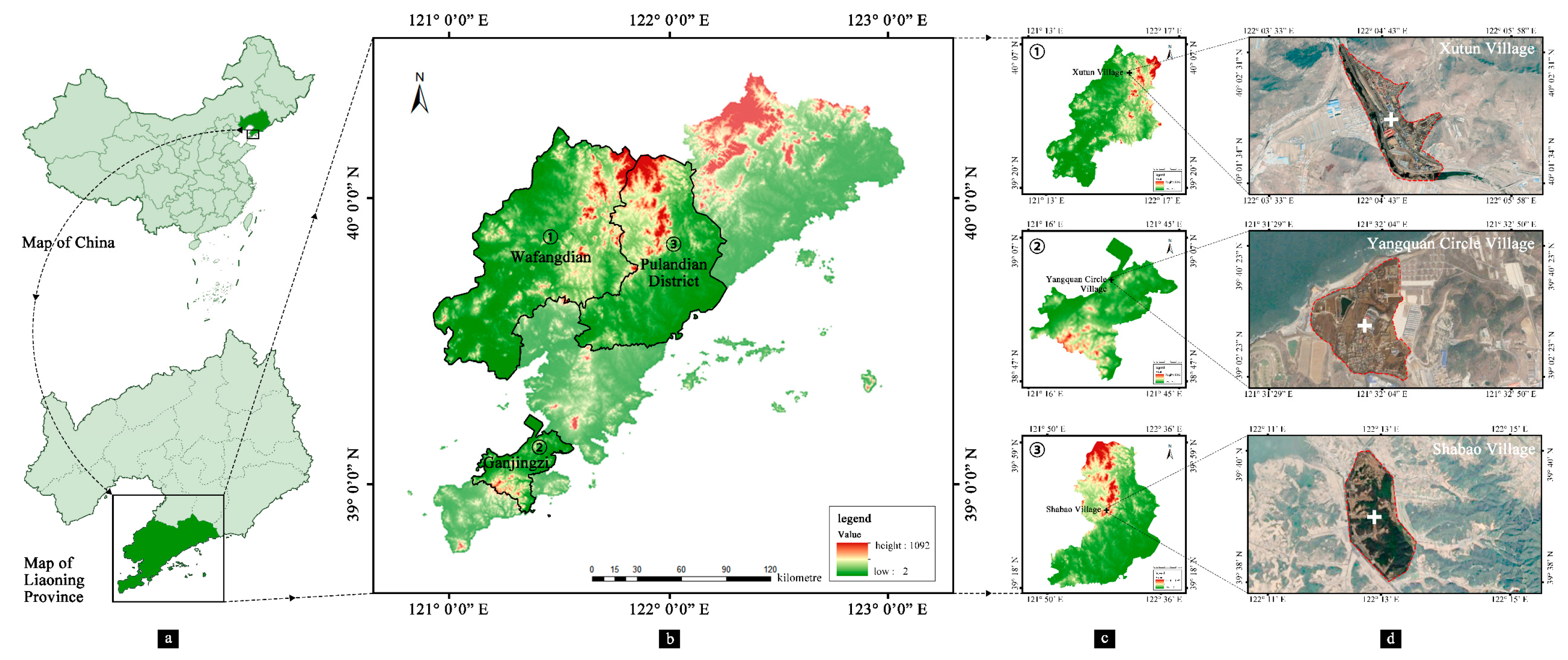
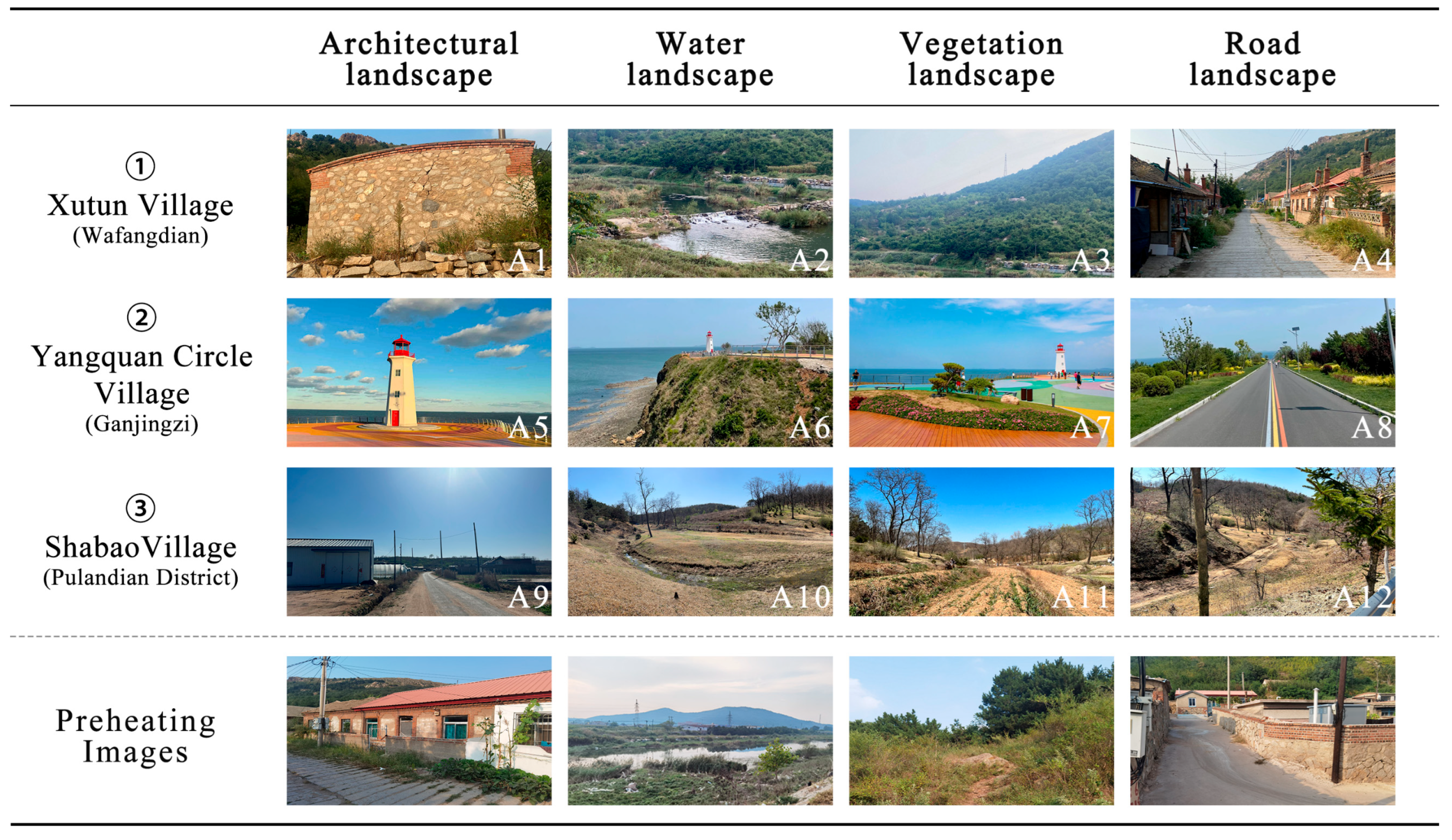

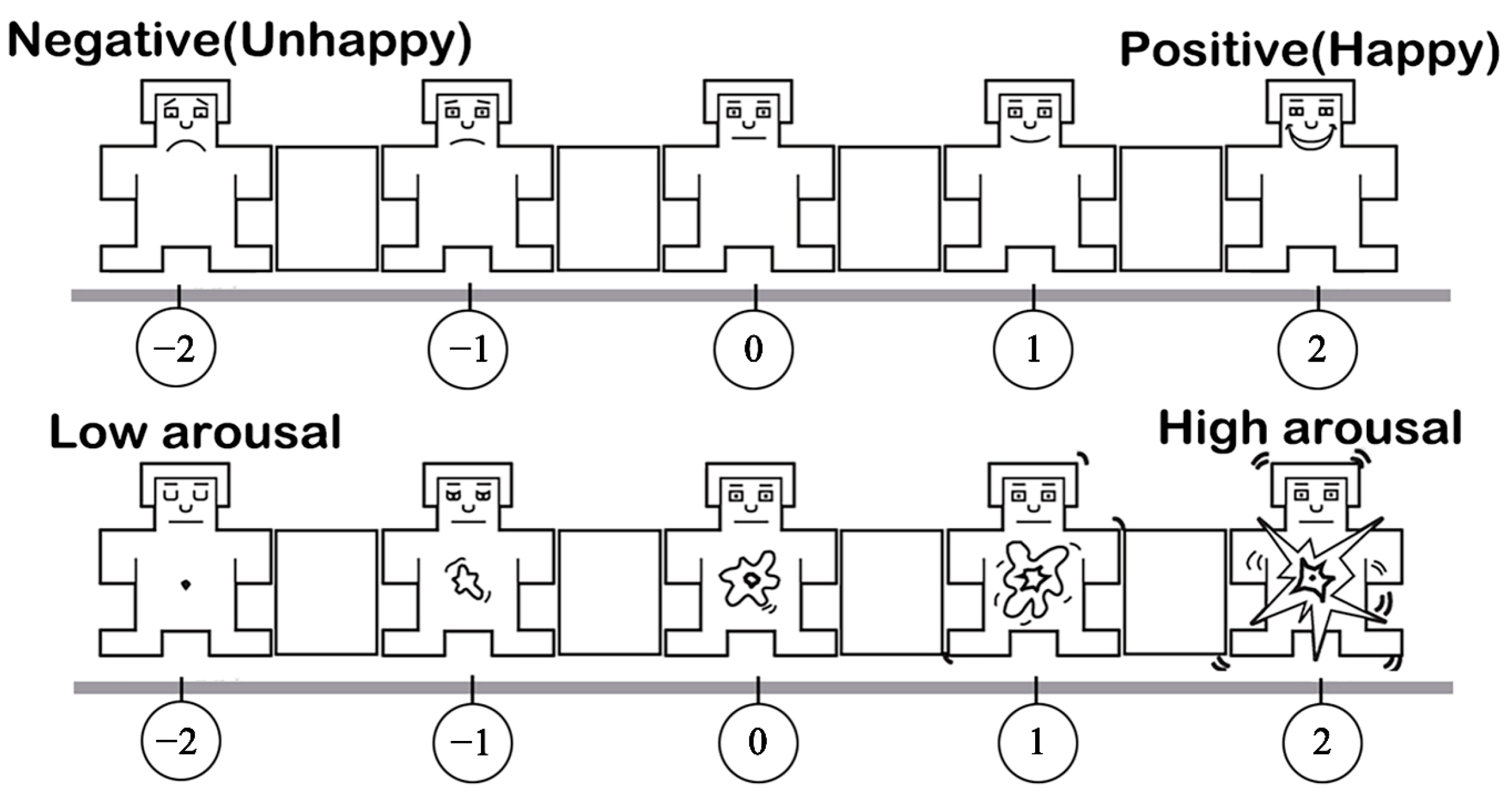
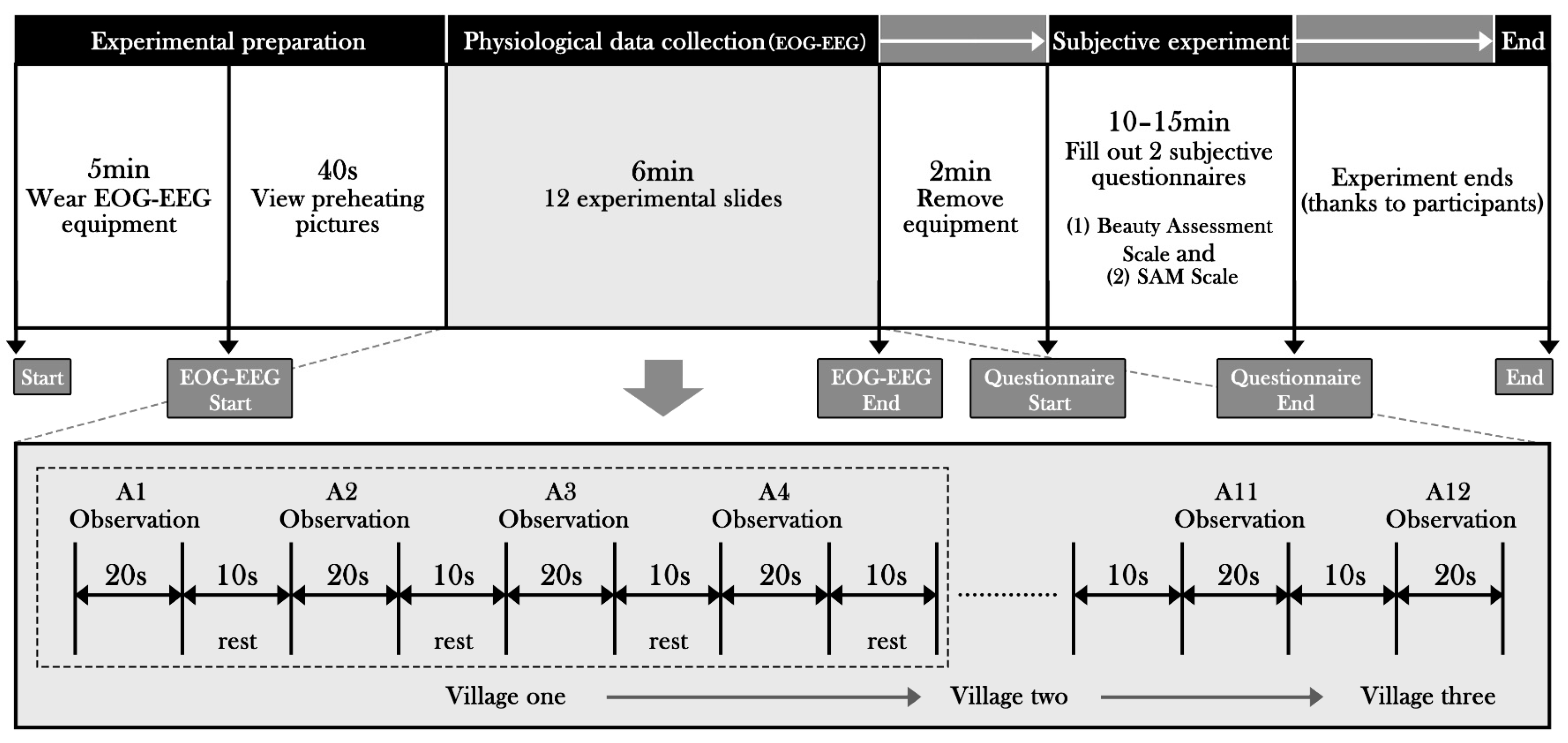

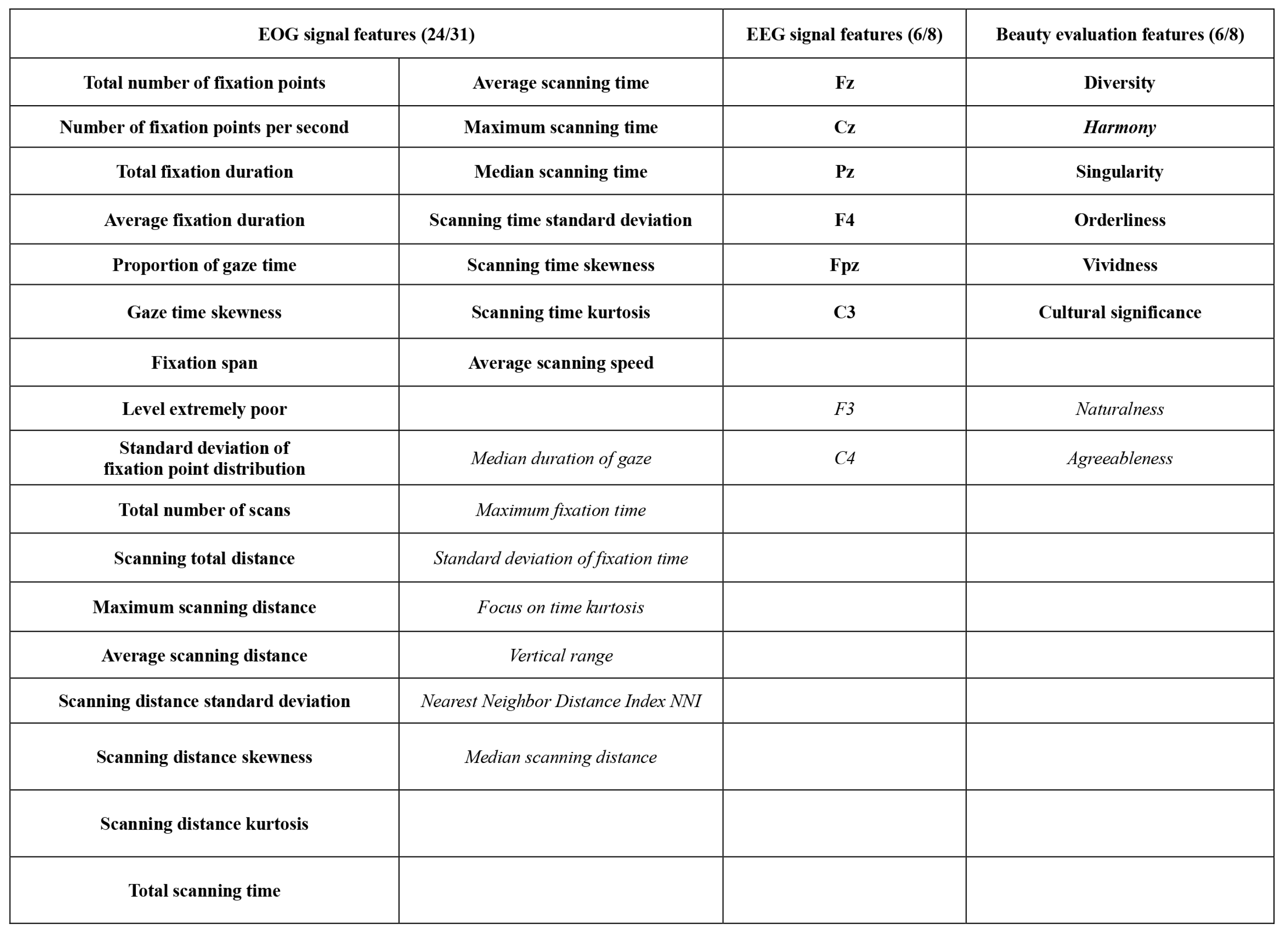
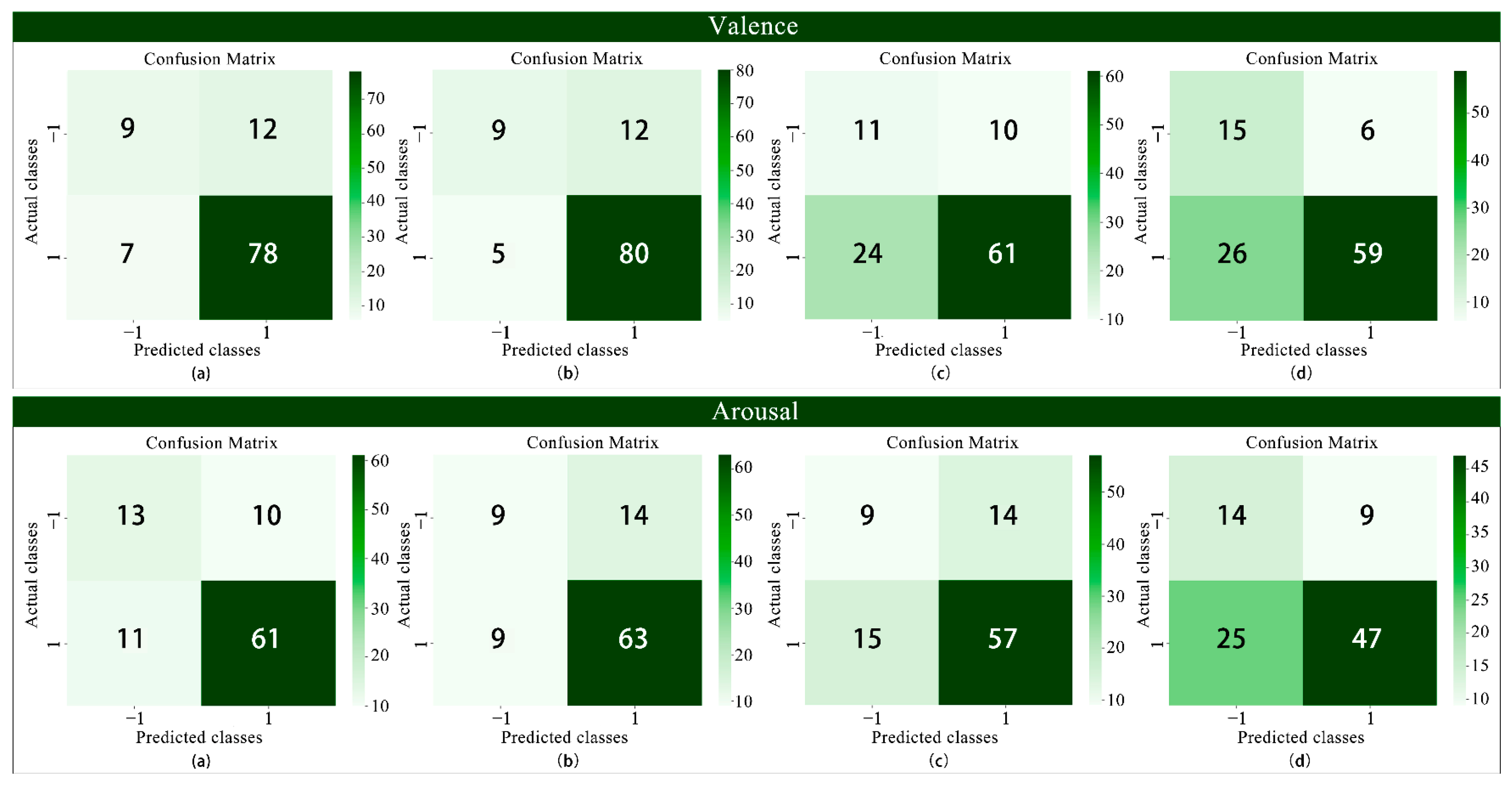
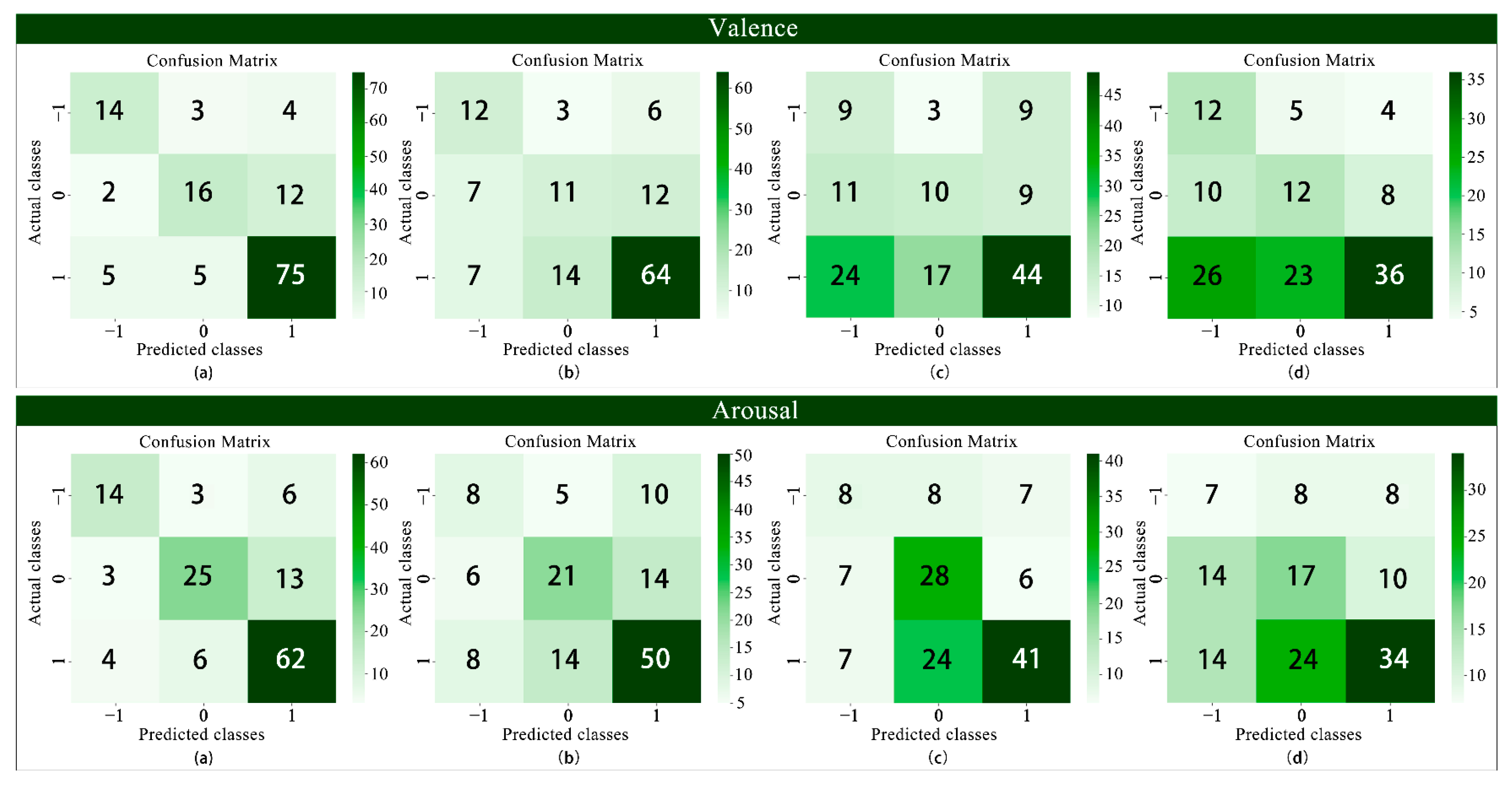

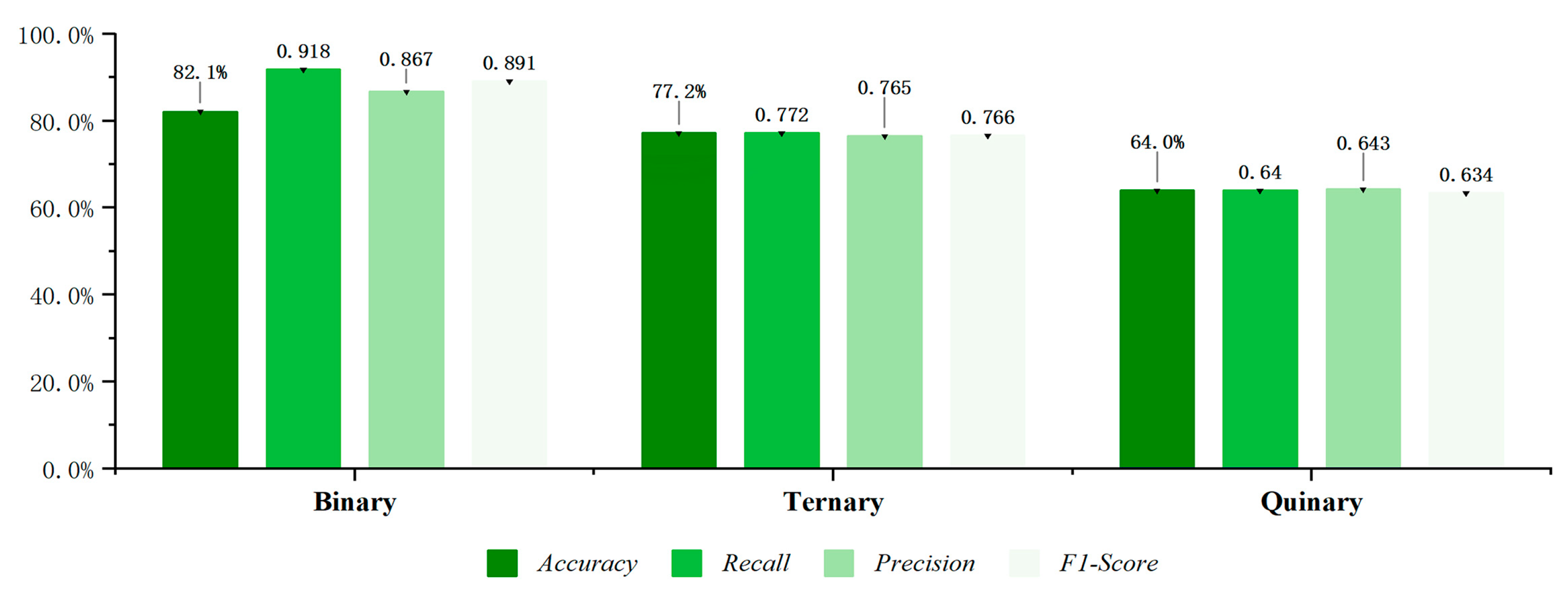
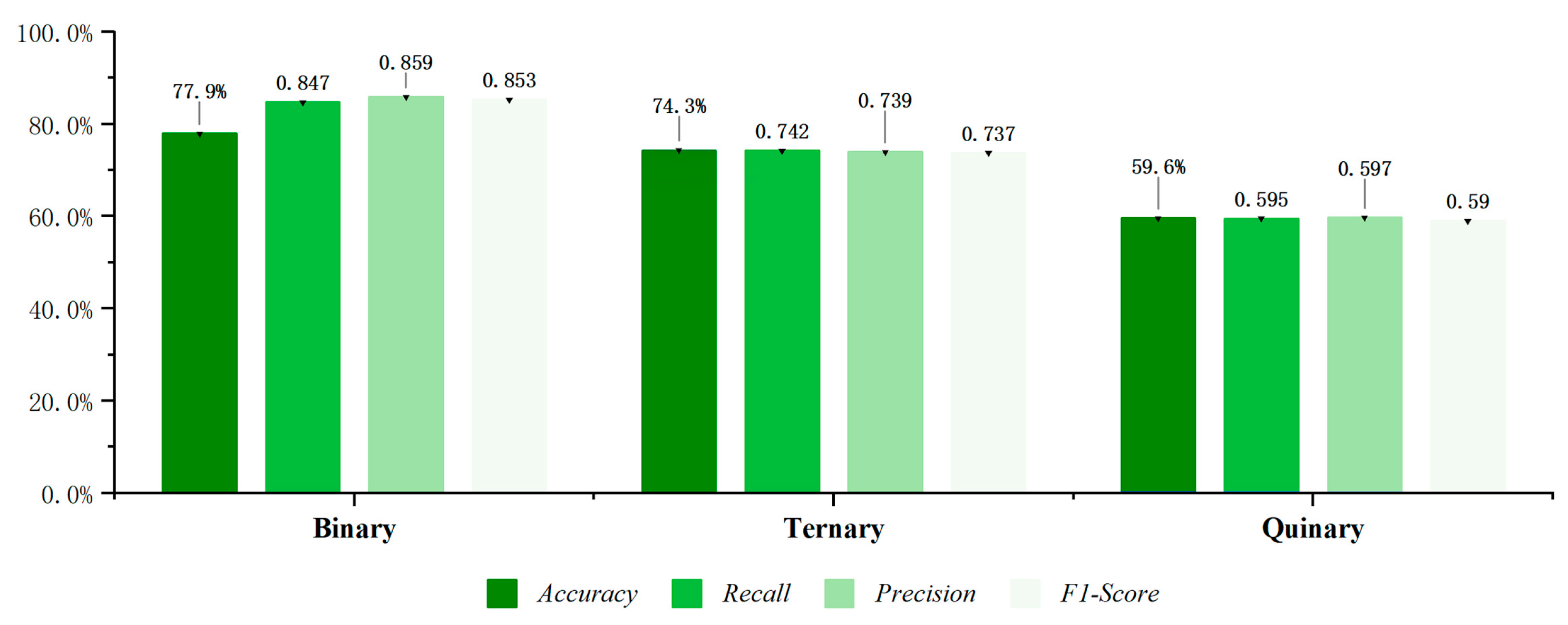
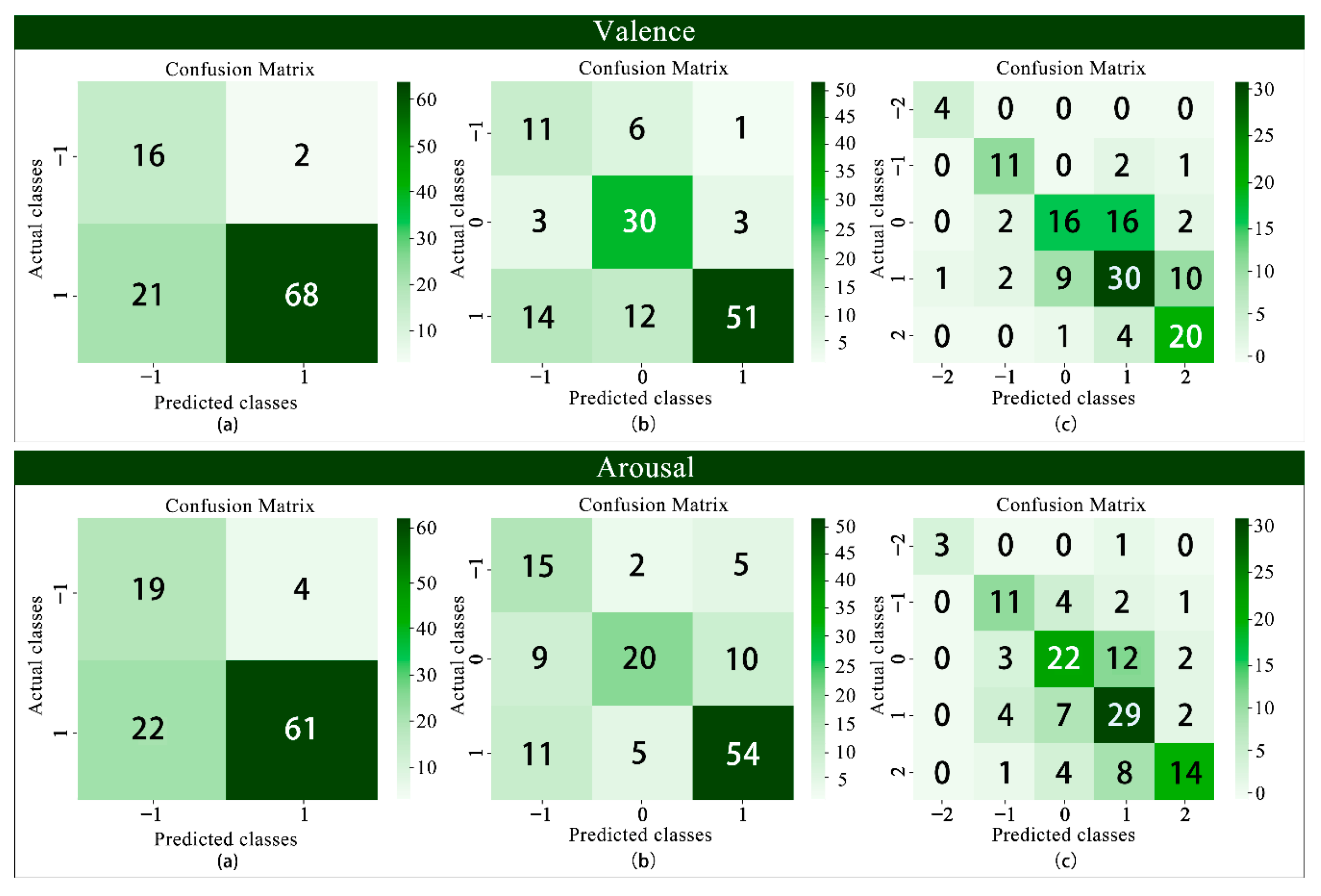
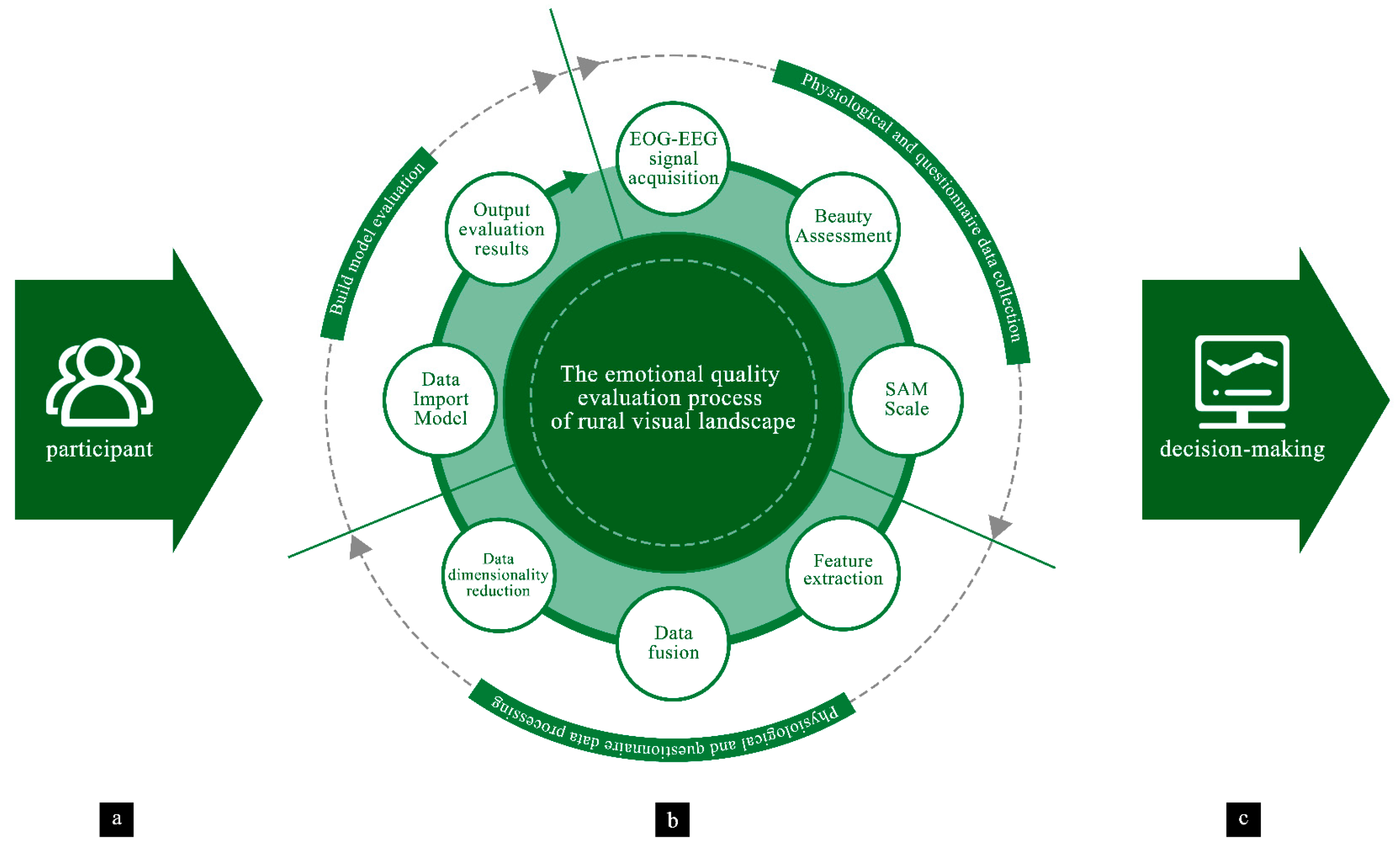
| Variable | Skewness | Kurtosis | Minimum Value | Maximum Value | Average Value | Standard Deviation |
|---|---|---|---|---|---|---|
| Naturalness | −0.752 | −0.306 | 1 | 5 | 3.80 | 1.156 |
| Diversity | −0.198 | −0.684 | 1 | 5 | 3.14 | 1.113 |
| Harmony | −0.244 | −0.761 | 1 | 5 | 3.32 | 1.135 |
| Singularity | 0.092 | −0.722 | 1 | 5 | 2.85 | 1.142 |
| Orderliness | −0.201 | −0.752 | 1 | 5 | 3.20 | 1.130 |
| Vividness | −0.202 | −0.487 | 1 | 5 | 3.24 | 1.064 |
| Culture | −0.185 | −0.636 | 1 | 5 | 3.09 | 1.104 |
| Agreeableness | −0.185 | −0.692 | 1 | 5 | 3.32 | 1.170 |
| Class | Classifier | 47 Features | 36 Features | ||||||
|---|---|---|---|---|---|---|---|---|---|
| Accuracy | Recall | Precision | F1-Score | Accuracy | Recall | Precision | F1-Score | ||
| Binary | XGBoost | 79.3% | 0.918 | 0.839 | 0.876 | 82.1% | 0.918 | 0.867 | 0.891 |
| RF | 79.3% | 0.918 | 0.839 | 0.876 | 84.0% | 0.941 | 0.870 | 0.904 | |
| Ternary | XGBoost | 65.4% | 0.654 | 0.654 | 0.630 | 77.2% | 0.772 | 0.765 | 0.766 |
| RF | 62.5% | 0.625 | 0.606 | 0.611 | 64.0% | 0.640 | 0.646 | 0.642 | |
| Class | Classifier | 47 Features | 36 Features | ||||||
|---|---|---|---|---|---|---|---|---|---|
| Accuracy | Recall | Precision | F1-Score | Accuracy | Recall | Precision | F1-Score | ||
| Binary | XGBoost | 72.9% | 0.804 | 0.816 | 0.810 | 77.9% | 0.847 | 0.859 | 0.853 |
| RF | 70.8% | 0.750 | 0.811 | 0.780 | 75.8% | 0.875 | 0.818 | 0.846 | |
| Ternary | XGBoost | 59.6% | 0.596 | 0.591 | 0.582 | 74.3% | 0.743 | 0.740 | 0.738 |
| RF | 57.4% | 0.574 | 0.556 | 0.558 | 58.1% | 0.581 | 0.578 | 0.579 | |
| Emotional Category | Classifier | Accuracy | Recall | Precision | F1-Score |
|---|---|---|---|---|---|
| Valence | XGBoost | 82.1% | 0.918 | 0.867 | 0.891 |
| RF | 84.0% | 0.941 | 0.870 | 0.904 | |
| DT | 67.9% | 0.718 | 0.859 | 0.782 | |
| LR-GD | 69.8% | 0.694 | 0.908 | 0.787 | |
| Arousal | XGBoost | 77.9% | 0.847 | 0.859 | 0.853 |
| RF | 75.8% | 0.875 | 0.818 | 0.846 | |
| DT | 69.5% | 0.792 | 0.803 | 0.797 | |
| LR-GD | 64.2% | 0.653 | 0.839 | 0.734 |
| Emotional Category | Classifier | Accuracy | Recall | Precision | F1-Score |
|---|---|---|---|---|---|
| Valence | XGBoost | 77.2% | 0.772 | 0.765 | 0.766 |
| RF | 64.0% | 0.640 | 0.646 | 0.642 | |
| DT | 46.3% | 0.463 | 0.549 | 0.490 | |
| LR-GD | 44.1% | 0.441 | 0.574 | 0.468 | |
| Arousal | XGBoost | 74.3% | 0.743 | 0.740 | 0.738 |
| RF | 58.1% | 0.581 | 0.578 | 0.579 | |
| DT | 56.6% | 0.566 | 0.604 | 0.572 | |
| LR-GD | 42.7% | 0.427 | 0.485 | 0.445 |
| Emotional Category | Classifier | Accuracy | Recall | Precision | F1-Score |
|---|---|---|---|---|---|
| Valence | XGBoost | 64.0% | 0.640 | 0.643 | 0.634 |
| RF | 47.8% | 0.478 | 0.487 | 0.476 | |
| DT | 26.5% | 0.265 | 0.301 | 0.268 | |
| LR-GD | 26.5% | 0.265 | 0.335 | 0.278 | |
| Arousal | XGBoost | 59.6% | 0.596 | 0.598 | 0.590 |
| RF | 44.1% | 0.441 | 0.475 | 0.452 | |
| DT | 30.9% | 0.309 | 0.329 | 0.313 | |
| LR-GD | 24.3% | 0.243 | 0.349 | 0.265 |
| Emotional Category | Accuracy | Recall | Precision |
|---|---|---|---|
| Valence | 78.50% | 70.23% | 61.83% |
| Arousal | 75.47% | 67.94% | 58.46% |
Disclaimer/Publisher’s Note: The statements, opinions and data contained in all publications are solely those of the individual author(s) and contributor(s) and not of MDPI and/or the editor(s). MDPI and/or the editor(s) disclaim responsibility for any injury to people or property resulting from any ideas, methods, instructions or products referred to in the content. |
© 2025 by the authors. Licensee MDPI, Basel, Switzerland. This article is an open access article distributed under the terms and conditions of the Creative Commons Attribution (CC BY) license (https://creativecommons.org/licenses/by/4.0/).
Share and Cite
Zhao, X.; Lin, L.; Guo, X.; Wang, Z.; Li, R. Evaluation of Rural Visual Landscape Quality Based on Multi-Source Affective Computing. Appl. Sci. 2025, 15, 4905. https://doi.org/10.3390/app15094905
Zhao X, Lin L, Guo X, Wang Z, Li R. Evaluation of Rural Visual Landscape Quality Based on Multi-Source Affective Computing. Applied Sciences. 2025; 15(9):4905. https://doi.org/10.3390/app15094905
Chicago/Turabian StyleZhao, Xinyu, Lin Lin, Xiao Guo, Zhisheng Wang, and Ruixuan Li. 2025. "Evaluation of Rural Visual Landscape Quality Based on Multi-Source Affective Computing" Applied Sciences 15, no. 9: 4905. https://doi.org/10.3390/app15094905
APA StyleZhao, X., Lin, L., Guo, X., Wang, Z., & Li, R. (2025). Evaluation of Rural Visual Landscape Quality Based on Multi-Source Affective Computing. Applied Sciences, 15(9), 4905. https://doi.org/10.3390/app15094905






